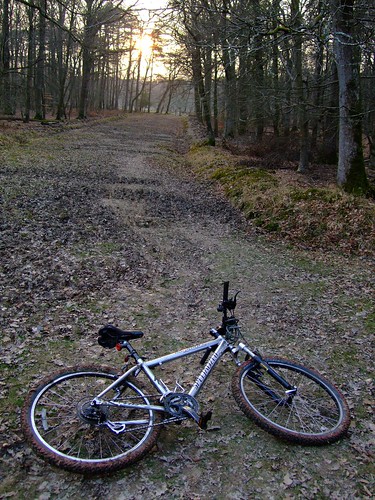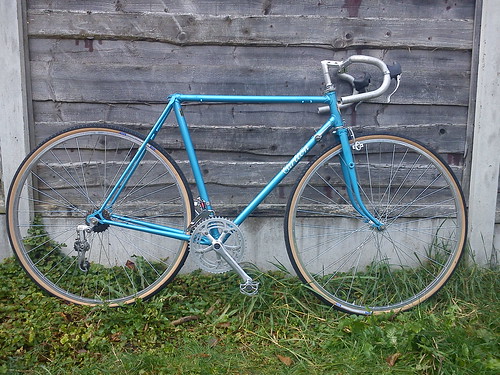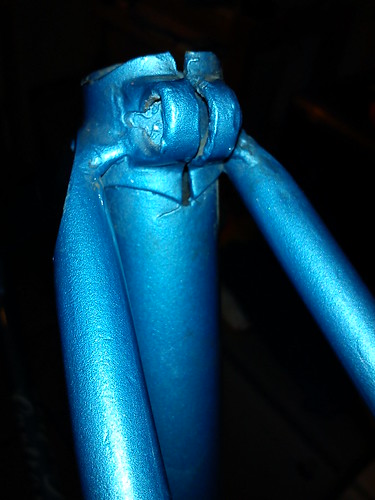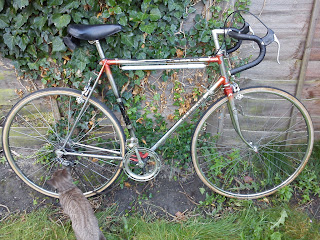But it's not quite as simple as that.. MTBs aren't just gears - they're also frame geometry, wheels, tyres, and suspension. Unlike the racing frames, they're built to ride over whatever is thrown in front of them. This became apparent when autumn got into full swing, and I found myself cycling over slippery fallen leaves on slim road tyres and a rigid frame. It was scary! I was constantly worried that the wheels would slip from under me, and I'd end up under a bus.
The front wheel issue got me back on the MTB, and I realised how much better it was at dealing with leaves. I missed the singlespeed, though. I missed it's direct power, and the general feel of riding without having to worry about anything gear related. Sure, I could ride without changing gear, like I generally did anyway, but it wasn't the same, somehow.
Onto the conversion...
Shopping list:
DMR STS Combo Kit (some spacers, a 16T cog, and a tensioner) - £33
Cassette removal tool - £6
A chain - £6
Total cost: £45
First, I took the rear wheel off, and removed the QR skewer. The cassette removal tool included a guide, so there was no need to clamp it in place with anything. It slotted nicely into the hub. Then I used a chain whip, which I've had for years for removing oil filters from cars, and an adjustable wrench to unscrew the locknut.
With the locknut off, the cassette came off easily, with the 11 and 12 tooth cogs falling away from the rest. The other six cogs were screwed together using a bolt with the tiniest hex diameter I've ever seen.
Next, I added a couple of the larger spacers, put the cog in, and added the rest of the spacers, and put the locknut back on. I put the wheel back onto the bike, and tried to tell if it would be a decent chainline.. I still have no idea! It looked kind've straight, but I know from experience that it's very hard to tell by eye. It wouldn't be hard to adjust later, so I left it like that, and turned my attention to the deraileurs.
The deraileurs came off simply enough - just some bolts to undo. I wasn't intending to keep the gear cables, so I snipped them using my brake cable cutter. Did I mention that I was doing this in my lunchbreak? No time for fiddling with tiny screws and uncooperative wires!
With the deraileurs off, I attached the tensioner. There are two parts to it - one bit that slots into the dropout, and is secured using the QR skewer, and the tensioner arm itself, which screws into that, and to the gear hanger.
Next was the chain, and this is where things started going wrong. The problem with mountain bikes is that most of them, including mine, have vertical dropouts. That means the wheel can't be moved back and forth to take up chain slack, so a tensioner is required to do that job. When trying to join the chain, the links were only 3mm away from a near perfect fit, but they were 3mm too far apart, not too close. I had to use the next link down the line, which made the chain VERY slack. The chain was so slack that the tensioner couldn't operate in it's intended configuration (pushing up on the chain), as it hit the chainstay before taking up the slack, so I had to set it to push down instead.
That setup actually worked! Well.. sort-of. It turned out that 42-16 was a bit of a rubbish gear ratio, equivalent to 5th gear, but it felt more like 4th, and pedalling felt clumsy and faster than necessary. That was going home, which is entirely uphill, so I was dreading trying it on the way into work! Another problem is the width of the chain - it's exactly the same width as the groove in the tensioner, so it's being slightly gripped by it. The sound it makes as it grips/releases the links is very weird! Kind've like a fluttering noise. To fix it, I can either buy a thinner 9/10-speed chain, or shave the tensioner a bit to make the groove wider. I'm going for shaving, using a file!
So, once home, I got the old cassette out, found a suitably tiny hex key, and split the cassette into seperate cogs. Seperate, filthy cogs. Some soap and water cleaned them up, and I had myself a 14-tooth cog for use in the morning. It was getting too late to work on the bike, so I intended to do it during my lunch break..
Well, 4 miles on a 5.2 gear ratio, going downhill, put paid to that idea. It was horrible! I swung into Cringle Park, in Levenshulme, turned the bike on it's back, and got the tools out again. Wheel off, locknut off, spacers off, 16T cog off, 14T cog in, etc, etc.. As an added bonus, the change in cog size meant the chain could be reduced to a less flappy length. The tensioner was still close to hitting the chainstay, but it was doing it's job. The ride from that point was far more agreeable! :)
On my lunchbreak, I decided to try out a different gear ratio, using the 34-tooth chainwheel and the 12-tooth cog, to see if it improved the chain slack at all. It didn't - it would've been extremely flappy again, so I left the chain the length it was, and went back to 42-14.
So, I guess I'll have to live with it the way it is. I'd like the chain to be a little shorter, but it's just not possible with the cogs that I've got, and I'm not sure I want to go off buying cogs to see if they improve matters. It's not bad, as such. Just not perfect!
There are two final tasks to complete, now. The 24 and 34 tooth chainwheels are still attached, and I want to take them off. The crank arm isn't coming off without a fight, though. The mallet just isn't getting through, so I need to ride it for a bit with the nut off. I might spray some WD40 into it to see if that also helps. I'm not sure if I should attempt this on the way home.. it'll probably wait until the most dangerous point before my entire chainset falls off. :P
The other task is to replace the brakes. My bike has Shimano Altus combined shifters and brakes (ugly things), so I can't just detach the shifters. I've got some Acera levers on order, which have the added bonus of looking much nicer!
All in all, the conversion has been relatively pain-free. The bike hasn't been rendered unusable for any length of time, which is a win in my book. :)
 |
| My MTB, back in the day |
It does leave me with a new problem, however.. Apart from the tyres, all of the components are original, from when I bought it 8 years ago. They're all a bit scuffed, and are making the bike look very shabby! I found some photos of the bike from 2009, and it was looking much snazzier, despite having been riden through a muddy forest for a few hours. So the new task is to start replacing parts to make it look a bit more presentable.
At least I don't have to worry about replacing the deraileurs!




